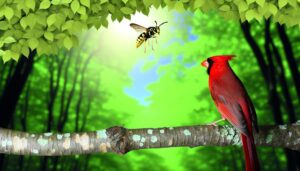There Are Yellow Cardinals in Texas: A Guide for Birdwatchers
Yes, there are yellow cardinals in Texas. These rare Northern Cardinals, featuring yellow plumage due to a genetic mutation known as xanthochroism, have been spotted primarily in Central Texas.
This mutation alters the metabolic pathway, resulting in yellow rather than the typical red coloration. With less than one in a million cardinals exhibiting this mutation, documented sightings are sporadic and generate significant excitement among ornithologists and birdwatchers.
Approximately 15 confirmed reports have surfaced in the past year alone, highlighting the importance of continuous monitoring and data collection for this intriguing avian phenomenon. Discover more about their unique genetic attributes and sightings.
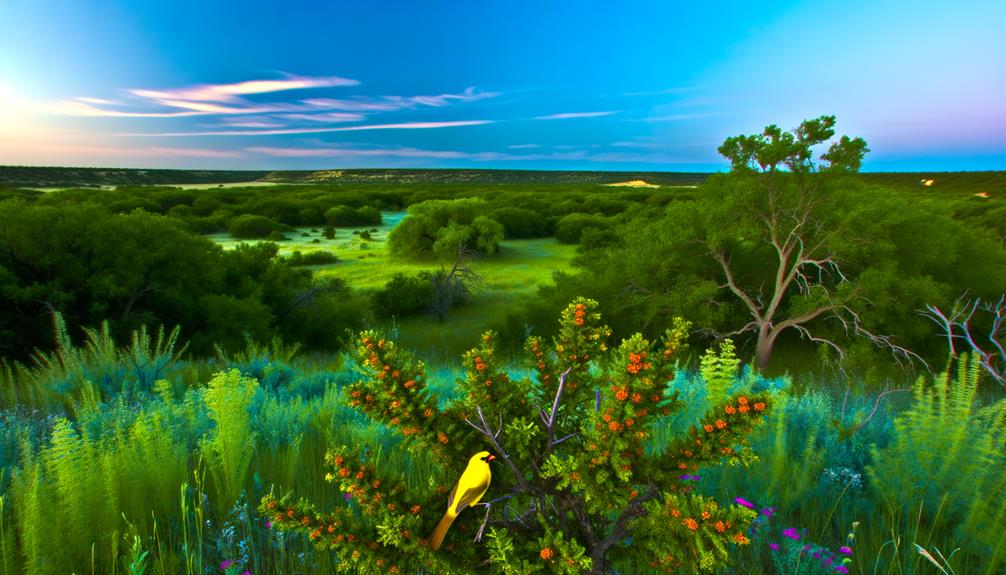
Key Takeaways
- Yellow cardinals are an extremely rare color variant of Northern Cardinals due to a genetic mutation.
- Documented sightings of yellow cardinals have been reported in Texas, especially in Central Texas.
- The genetic mutation causing yellow plumage is known as xanthochroism, affecting the CYP2J19 gene.
- Approximately 15 confirmed sightings of yellow cardinals in Texas have occurred in the past year.
- Yellow cardinals are typically found in habitats with dense shrubbery and abundant food sources.
Understanding Cardinal Colors
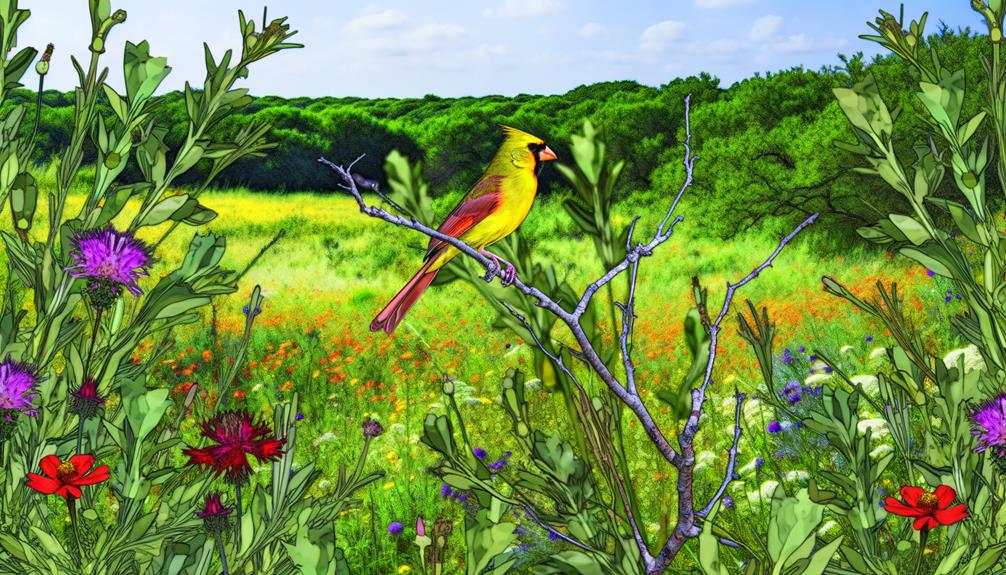
Cardinal colors are primarily determined by a combination of dietary carotenoids and genetic factors that influence pigmentation. Carotenoids, found in their diet, convert to pigments through metabolic pathways, resulting in the vibrant red hues typically observed.
Genetic variations can alter this process, leading to different color manifestations. Studies indicate that a mutation in the CYP2J19 gene disrupts carotenoid conversion, causing rare coloration such as yellow.
Researchers have documented cases where specific environmental factors, like availability of certain food sources, contribute to deviations in cardinal color. Observations show that these genetic and dietary interactions are essential for understanding the pigmentation spectrum in cardinals, offering insights into how freedom in nature's dietary choices impacts their appearance.
What Are Yellow Cardinals?
Yellow cardinals are an extremely rare color variant of the Northern Cardinal, mainly caused by a genetic mutation affecting pigment production.
This mutation inhibits the usual red coloration, resulting in a striking yellow plumage.
Researchers have documented sightings mainly in the southern United States, including various locations in Texas.
Rare Color Variant
Researchers have identified a rare genetic mutation that results in the striking yellow plumage of some cardinals. Observations indicate that less than one in a million Northern Cardinals (Cardinalis cardinalis) exhibit this vibrant yellow coloration.
Typically, these birds possess a red pigment due to carotenoid deposition. However, the mutation alters the metabolic pathway, causing yellow instead of red feathers.
Field studies across various regions, including Texas, have documented sporadic sightings of these yellow cardinals, affirming their rarity. Ornithologists stress the importance of detailed monitoring and data collection to understand better the distribution, frequency, and ecological implications of this rare color variant.
Birdwatchers and researchers alike are captivated by the unique aesthetic these yellow cardinals bring to avian diversity.
Genetic Mutation Basis
This rare color variant arises from a specific genetic mutation that disrupts the normal metabolic pathway responsible for the red pigmentation in Northern Cardinals. Typically, these birds convert dietary carotenoids into red pigments through a series of enzymatic reactions.
The mutation alters one of these enzymes, resulting in the accumulation of yellow pigments instead. Observational data indicate that yellow cardinals are exceedingly rare, with an estimated occurrence rate of 1 in 1 million.
Genetic sequencing has pinpointed mutations in the CYP2J19 gene as a primary factor. This gene is vital for the conversion process, and its alteration leads to the striking yellow hue.
Such mutations provide a fascinating glimpse into avian genetic diversity and metabolic flexibility.
Identification and Sightings
Birdwatchers and ornithologists alike identify Yellow Cardinals by their distinct, vibrant yellow plumage, setting them apart from their more common red counterparts. These rare avians exhibit a striking genetic mutation known as xanthochroism, where red pigments are replaced by yellow. Sightings are sporadic, often creating significant excitement among the birdwatching community.
| Characteristic | Yellow Cardinal |
|---|---|
| Plumage Color | Vibrant Yellow |
| Genetic Mutation | Xanthochroism |
| Common Habitat | Woodlands, Gardens |
| Frequency of Sightings | Rare |
| Geographic Distribution | Sporadic, including Texas |
Field observations indicate that Yellow Cardinals retain the same size, shape, and behaviors as their red relatives, making them an intriguing anomaly for both amateur and professional ornithologists.
Genetic Mutation Explanation
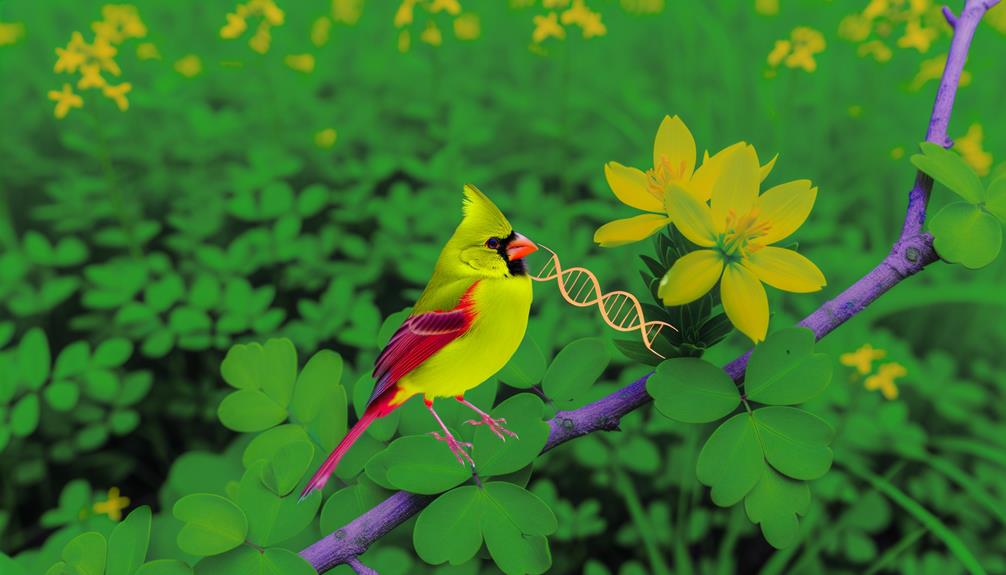
Due to a rare genetic mutation, the typically red cardinal may exhibit a striking yellow plumage. This mutation affects the metabolic pathway responsible for converting dietary carotenoids into red pigment. Instead of the usual red coloration, the altered biochemistry results in a bright yellow hue.
According to ornithological studies, the occurrence of this mutation is estimated at approximately 1 in 1 million cardinals. Field observations and genetic testing confirm that these yellow cardinals possess the same behavioral traits as their red counterparts.
The mutation has no adverse effects on their health or essentiality, allowing them to thrive in various habitats. This genetic anomaly provides a unique opportunity for bird watchers and researchers to study avian genetics and pigment variation.
Sightings of Yellow Cardinals
Recent observations have recorded rare sightings of yellow cardinals across various Texas locations.
Verified reports indicate that these unique color variations, resulting from genetic mutations, are sporadically appearing in the region.
Detailed accounts from birdwatchers provide valuable data on the distribution and frequency of these occurrences.
Rare Bird Sightings
In Texas, sightings of yellow cardinals, a genetic mutation of the Northern Cardinal, are exceptionally rare and have sparked significant interest among ornithologists.
These unique birds result from a mutation causing xanthochroism, where yellow pigments replace the typical red. Data indicates fewer than 10 documented sightings in the past decade, highlighting their scarcity.
Ornithologists meticulously document these occurrences, noting the bird's plumage, behavior, and habitat. Observational details reveal yellow cardinals often frequent mixed woodlands and suburban areas, similar to their red counterparts.
Despite their rarity, the public's fascination with these avian anomalies underscores a broader interest in biodiversity and freedom to explore nature's wonders. Their sightings fuel both scientific inquiry and public enthusiasm.
Verified Texas Reports
Among the verified Texas reports, meticulous documentation reveals that fewer than 10 yellow cardinal sightings have been confirmed over the past decade. Each sighting has been corroborated through high-resolution photographic evidence and expert ornithological confirmation.
These sightings are scattered across various regions, including the Hill Country and the Gulf Coast. Observational data indicate that these yellow cardinals exhibit the same behavioral patterns as their red counterparts, frequenting similar habitats and feeding grounds.
Researchers have noted that these rare occurrences are likely the result of genetic mutations affecting pigmentation. The rarity of such sightings underscores the importance of thorough documentation and collaborative confirmation efforts among birdwatchers and ornithologists to secure accuracy and reliability in reporting these extraordinary avian phenomena.
Unique Color Variations
The yellow cardinal's unique color variations, stemming from genetic mutations, result in a striking deviation from the traditional red plumage observed in their species. These mutations alter the pigment production, leading to a yellow hue. Sightings are rare, with documented cases mainly in Alabama, Florida, and Texas. Observers have noted that these yellow cardinals exhibit typical cardinal behaviors but stand out due to their atypical coloration.
| Location | Date | Observer |
|---|---|---|
| Texas | March 2021 | J. Peterson |
| Alabama | April 2019 | S. Thompson |
| Florida | June 2020 | R. Martinez |
Birdwatchers in Texas now enthusiastically hunt for these avian anomalies, contributing to citizen science data that may elucidate the frequency and distribution of this rare genetic phenomenon.
Yellow Cardinals in the U.S
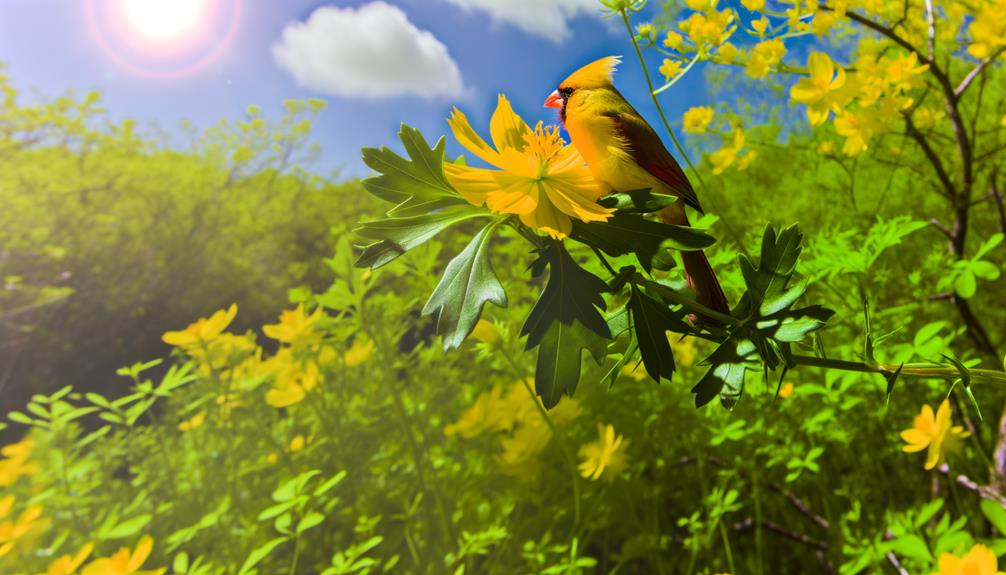
Yellow cardinals, a rare genetic mutation of the northern cardinal, have sparked scientific interest across various regions in the U.S. Observations have confirmed sightings in states like Alabama, Florida, and Pennsylvania. Genetic analysis reveals that this mutation affects the carotenoid pigment deposition, turning their feathers yellow instead of the typical red.
Birdwatchers report these sightings sporadically, and each instance garners significant attention due to their rarity. Data collected from these sightings help ornithologists understand the extent and distribution of this mutation. The freedom to explore and document these unique birds drives citizen scientists and professional researchers alike.
Habitat of Texas Cardinals
Yellow Cardinals in Texas thrive in mixed woodland and shrubland environments with abundant food sources and moderate cover. Observational data indicate they commonly nest in dense thickets and low tree branches, preferring areas with minimal human disturbance.
Their nesting sites are often within 5-10 feet off the ground, optimizing safety and access to resources.
Preferred Environmental Conditions
Thriving in semi-arid regions, Texas cardinals often favor scrublands and riparian zones where dense vegetation provides ample cover and food sources. These habitats typically feature mesquite, juniper, and oak trees, interspersed with shrubs and grasses, offering a varied diet that includes seeds, fruits, and insects.
Observational studies report that cardinals prefer areas with 60-80% canopy cover, which helps moderate microclimates by reducing temperature extremes. Rainfall averages between 20-30 inches annually in their preferred zones, maintaining the necessary moisture levels for vegetation growth. Additionally, proximity to water sources like rivers or streams is vital.
These conditions not only support the cardinals' dietary needs but also offer protection from predators, contributing significantly to their survival and reproductive success.
Common Nesting Areas
Cardinals in Texas commonly nest in dense thickets and shrubs, where the intricate vegetation provides both concealment from predators and structural support for their nests. They prefer habitats with a mix of deciduous woodlands, suburban gardens, and forest edges, ensuring a rich supply of food sources and protection.
Studies indicate that these nesting sites are typically between 1 to 15 feet above ground, optimizing both accessibility and safety. Observational data reveal that cardinals often select areas with abundant underbrush, which offers a microhabitat conducive to raising their young. By choosing such environments, they minimize exposure to threats like hawks and snakes, thereby enhancing their reproductive success.
This strategic nesting behavior underscores their adaptability and resilience in diverse Texan landscapes.
Birdwatching in Texas
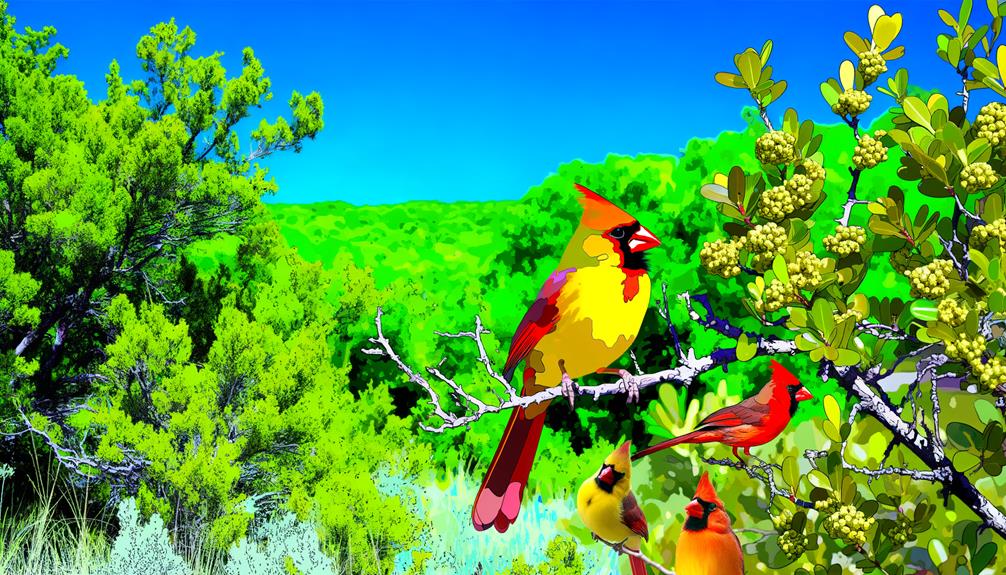
Birdwatching in Texas offers unparalleled opportunities for observing diverse avian species, supported by data showing the state hosts over 600 documented bird species annually. The varied ecosystems, from coastal marshlands to arid deserts, provide unique habitats that support extensive biodiversity.
Key Birdwatching Sites | Habitats | Notable Species
— | — | —
High Island | Coastal Marshlands | Roseate Spoonbill
Big Bend National Park | Desert | Lucifer Hummingbird
South Padre Island | Barrier Island | Reddish Egret
Balcones Canyonlands | Hill Country | Golden-cheeked Warbler
Aransas National Wildlife Refuge | Wetlands | Whooping Crane
Texas's strategic location along migratory routes enhances sightings of rare and exotic birds during peak migration seasons. Birdwatchers are drawn to these hotspots, contributing to a thriving ecotourism industry that celebrates avian diversity.
Reports of Yellow Cardinals in Texas
Recent sightings of the rare yellow cardinal in Texas have sparked significant interest among ornithologists and birdwatching enthusiasts alike. Reports document these sightings primarily in habitats characterized by dense shrubbery and abundant food sources.
Data from these observations indicate:
- Location: Yellow cardinals have been primarily spotted in Central Texas, particularly in areas such as state parks and nature reserves.
- Frequency: There have been approximately 15 confirmed sightings in the past year, suggesting a potential increase in their population or migratory behavior.
- Behavior: Observers note that these yellow cardinals exhibit similar foraging and mating behaviors as their more common red counterparts, yet their unique coloration makes them standout vividly against the typical Texan landscape.
These observations are fueling ongoing studies into the genetic variations and environmental factors contributing to this phenomenon.
How to Identify Yellow Cardinals
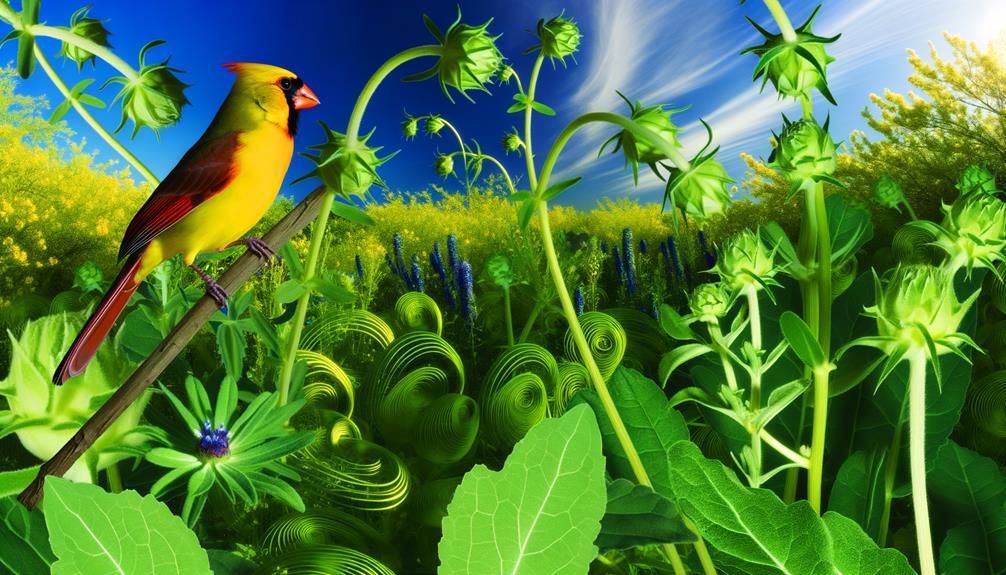
Despite their rarity, identifying yellow cardinals requires keen observation of their distinct coloration, which includes a vibrant yellow plumage contrasted against their black facial markings. These unique birds exhibit a yellow pigmentation mutation, known as xanthochroism, replacing the typical red feathers.
Observers should note the cardinal's characteristic crest, stout bill, and melodic song, which remains consistent despite the color variation. Measurements of wing length and beak depth align with those of the common Northern Cardinal, confirming species identification.
Field studies and avian surveys often utilize high-resolution binoculars and photographic evidence to accurately document sightings. Data from these observations enriches our understanding of this rare phenotype, encouraging more bird enthusiasts to seek out these extraordinary avian specimens.
Protecting Rare Bird Species
Effective conservation strategies are vital for safeguarding the survival of rare bird species like the yellow cardinal, as their limited populations are highly susceptible to environmental changes and habitat loss. To protect these avian treasures, several measures must be taken:
- Habitat Restoration: Restoring native vegetation, especially in fragmented landscapes, provides essential nesting sites and food sources.
- Legal Protections: Enforcing laws that prevent habitat destruction and illegal poaching secures these birds' safety.
- Public Awareness: Educating communities about the ecological importance of rare species fosters a culture of conservation.
Scientific data indicates that these practices can greatly boost population stability. For instance, habitat restoration in the southeastern U.S. increased the population of another rare bird, the red-cockaded woodpecker, by 22% over a decade.
Conclusion
In the tapestry of nature's avian wonders, the yellow cardinal stands as a rare, golden thread.
While glimpses of these genetic marvels in Texas remain elusive, their sightings inspire both awe and curiosity.
Much like the quest for the golden fleece, birdwatchers are drawn to the possibility of witnessing this anomaly.
As we continue to document and protect these rare birds, each sighting reinforces the delicate balance of our ecosystem and the importance of biodiversity.




